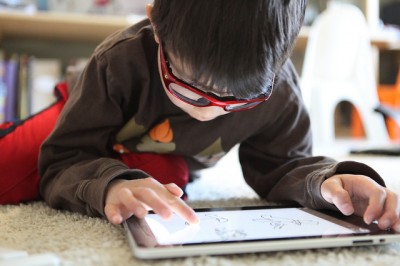Apple Tightens Its 94% Choke-hold On The Education Tablet Market
By Paul Glader on November 27, 2013
Blended Learning, Domestic, Education Quality, Ereaders, Friend, Fraud, or Fishy, K-12, Required
By Anya Kamenetz, The Hechinger Report
“Apple is making substantial contributions to society,” by “reinventing education,” CEO Tim Cook said during Monday’s quarterly earnings call. Celebrating their “highest September quarter revenue ever,” and their “best education quarter ever,” Cook and CFO Peter Oppenheimer highlighted global education more than any other growth market for the iPad specifically. Here are some of the examples they cited:
- Over $1 billion in the education category specifically for the first time ever, out of $37 billion in total revenue.
- Education sales were up 8% year over year.
- In the U.K., the number of iPads sold to K-12 schools has more than doubled year-over-year.
- In Latin America, over 70,000 iPads in use across 800 schools.
- The Coachella Valley School District in California is currently distributing over 19,000 iPads to its student body.
- Horry County School Districts in South Carolina will distribute 10,000 tablets to middle school students this year with a goal of providing all students in grades 3-12 with their own devices within three years.
- iBooks textbooks are now available across the U.S., U.K. and Australian national high school curricula.
- Apple’s share of tablets in education is 94%.
“It’s sort of unheard of,” crowed CEO Tim Cook. “I’ve never seen a market share that high before. So, we feel like we’re doing really well here and feel great to be making a contribution to education.”
The rise of the iPad in education has been impressive but not uncontroversial. As documented elsewhere on this blog, the devices have both passionate fans and passionate detractors among educators. Notably, Cook and Oppenheimer did not mention the ongoing $1 billion iPad rollout by the second largest school district in this country, LA Unified. Perhaps that’s because the rollout has been delayed due to security concerns and other implementation problems, a “fiasco” that led to resignation rumors for Superintendent John Deasy.
As I see it there are three major problems with one company having a 94% market share in a particular kind of classroom device. The first one is price and competition. In response to a question on the call about competition from the more modestly priced Google Chromebook, Tim Cook said “We do see Chromebooks in some places, but the vast majority of people are buying a PC/Mac or an iPad.”
Even with high-volume discounts, iPads can cost over $600 per student. Apple has consistently resisted making truly budget versions of its devices even when that meant losing market share to competitors, to say nothing of its purported social mission in an area like education. Not only are iPads expensive, they require monthly data plans for most applications, their components are near-impossible to repair or upgrade, and like most Apple products they are designed to be replaced every few years.
The second problem with massive iPad adoption is control of curriculum. The star iPad educators I’ve talked to are masters of the remix. They use dozens of different apps in their classrooms daily, most of which put students in an active role as content creators and communicators. It takes careful scaffolding and professional development to make teachers confident in applying this kind of technological creativity. In large scale iPad adoptions, especially those motivated by the transition to the Common Core, what we’re far more likely to see is Apple subcontracting out to providers like Pearson for an all-in-one, off-the-shelf curriculum solution that is little more than an automated textbook. As we’ve seen in LA, this can simultaneously disempower and confuse teachers, taking them out of the drivers’ seat, as well as lead to subpar experiences for students.
Finally, compared to bona fide computers, iPads are far less hackable. You can’t reprogram them without jailbreaking. Using them to write code is unwieldy. You can’t even open them up to change the battery. This puts an entire technological world off-limits in tablet-based classrooms.
Here’s a blog post by a friend of mine who is building a PC out of parts with his two school-aged daughters, using free videos found online as their coach. The girls will use the computer to play the wildly popular educational game Minecraft. The total cost is well under $300. Imagine if our public schools took this DIY approach to provisioning classrooms with computers.
Related Posts


Tips & Pitches
Latest WA Features
-
Online Courses Are Expanding, Along With Questions About Who Owns The Material
-
Why Size Matters: Consolidation Sweeps Across US Higher Ed
-
Trend: Corporate U Employers Offering Just In Time Education To Workers
-
Subterfuge & Skullduggery In The College Rankings Game
-
“Instreamia” Shakes Loose Moss By Launching Spanish Language Mini-MOOC
Domestic, Education Quality, For-Profit, Friend, Fraud, or Fishy, K-12, Legislation, Opinion, Personalized Learning, Regulatory, Required, Universities & Colleges - Apr 29, 2014 - 0 Comments
Michael Horn: NCAA March Madness Followed By April Blunder In Online Learning
More In For-Profit
- The Economy Is Forcing Tuition To Fall Rapidly At Private, For-Profit Colleges
- Kamenetz: Jeb Bush As Controversial Leader Of Aspen Task Force on Learning & The Internet
- Columnist Ryan Craig: The Best Of Times Could Return As For-Profit Edu Invests
- Bubble Analysis: Trace Urdan on Why This Era of Ed Investing Could Be Different
- A Blended Path? How American Honors Cuts Cost of Four Year Degree by Over a Third
Community Colleges Cost of Education Domestic For-Profit Required Student Loans Universities & Colleges
Cost of Education, Domestic, Education Quality, Friend, Fraud, or Fishy, Opinion, Personalized Learning, Required, Technology, Universities & Colleges - Jan 17, 2014 - 0 Comments
Online Education As A Postmodern Societal Response
More In Technology
- MakerBot Academy: A 3-D Printer In Every Classroom
- Michael Horn: A Look Behind The Curtain At How A MOOC Is Made
- Koller, Khan and Agarwal At The NYT’s Schools of Tomorrow Conference
- Video: New NESTA Report, Three Steps To Assess Digital Innovation in Education
- Norwegian Teens Publish Their Own Guide To Teaching and Learning In Web 2.0
Blended Learning Education Quality International K-12 Open Source Education Personalized Learning Required Technology
Domestic, Education Quality, For-Profit, Friend, Fraud, or Fishy, K-12, Legislation, Opinion, Personalized Learning, Regulatory, Required, Universities & Colleges - Apr 29, 2014 - 0 Comments
Michael Horn: NCAA March Madness Followed By April Blunder In Online Learning
More In Friend, Fraud, or Fishy
- Online Education As A Postmodern Societal Response
- Apple Tightens Its 94% Choke-hold On The Education Tablet Market
- Michael Horn: Why Obama’s Proposals Won’t Entirely Revolutionize HigherEd
- Columnist Ryan Craig: The Curious Case Of HigherEd Accreditation
- McGraw-Hill Executive Speaking About Big Data: “Don’t look at us, look at Joe Camel”
Domestic Ebooks Education Quality Ereaders Ethics Friend, Fraud, or Fishy K-12 Publishers & Curriculum Required Textbooks











Reply